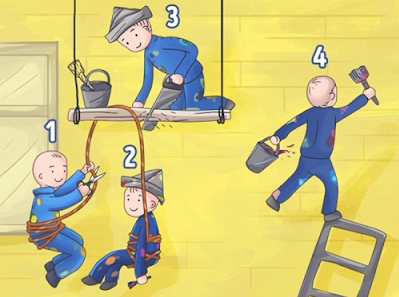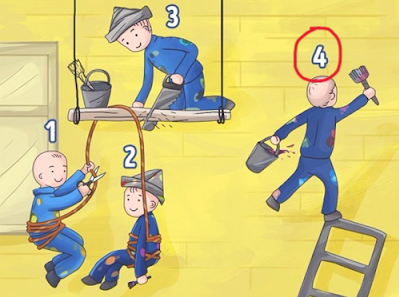Life often presents us with puzzles that challenge our logic and reasoning, and this scenario is no exception. Imagine a group of painters working on a yellow wall. At first glance, the scene seems ordinary, but the question looms: Who will fall first?
This riddle might seem simple, but it’s filled with nuances that require careful observation and critical thinking. Let’s analyze the situation step by step to uncover the answer while learning a thing or two about logical reasoning along the way.
The Puzzle: Who’s Most Likely to Fall?

The image features four painters, each in a precarious position:
- Painter #1 is standing on the ground, holding a rope that supports Painter #2.
- Painter #2 is sitting on a wooden plank suspended by the rope Painter #1 is holding.
- Painter #3 is sawing through the wooden plank that Painter #2 is sitting on.
- Painter #4 is standing on a ladder, holding a paint bucket and brush.
Your task is to determine which painter will fall first. At first glance, the answer seems obvious, but is it? Let’s break it down.
Common Missteps When Solving This Puzzle
Before diving into the analysis, it’s important to understand why many people get this wrong.
- Rushing to Conclusions: Most people fixate on Painter #3, assuming the sawing action makes them the likeliest to fall. But is that true?
- Ignoring Small Details: Key elements like the stability of the ladder or the tension in the rope are often overlooked.
- Overthinking the Situation: Some people imagine scenarios that aren’t shown in the picture, leading to inflated guesses.
To solve the puzzle, we need a systematic approach that considers every factor.
Analyzing Each Painter’s Situation
Painter #4: The Ladder Problem
Painter #4 stands on a ladder while holding a bucket of paint and a brush. Their position raises immediate red flags:
- Ladders are inherently unstable, especially when someone is holding additional weight like a paint bucket.
- A slight shift or wobble could cause the ladder to lose balance.
- Painter #4 could fall at any moment if the ladder tips or the ground underneath shifts.
While Painter #4 seems vulnerable, their fate depends on the ladder’s stability.
Painter #3: The Sawing Saboteur
Painter #3 is sawing through the plank that Painter #2 is sitting on. Here’s the key consideration:
- If Painter #3 successfully cuts through the plank, both they and Painter #2 will fall.
- However, sawing through a wooden plank takes time. Painter #3 might not finish cutting before another event occurs, such as Painter #4 falling.
- Painter #3’s actions are risky but not necessarily the first domino in this scenario.
Painter #2: The Passive Observer
Painter #2 is sitting on the plank, relying entirely on Painter #1 to hold the rope. Their situation is precarious because:
- If Painter #1 loses grip or lets go of the rope, Painter #2 will fall immediately.
- Painter #3’s sawing adds another layer of risk, as a cut plank will result in their fall.
- However, Painter #2 is not taking any active steps to cause their own fall, making them less likely to fall first.
Painter #1: The Rope Holder
Painter #1 is standing on solid ground, holding the rope that suspends Painter #2. While their position seems secure, there are considerations:
- If Painter #1 loses grip on the rope, Painter #2 will fall immediately.
- Painter #1’s stability depends on external factors, such as sudden movements or distractions.
Painter #1 is the least likely to fall themselves but plays a critical role in determining Painter #2’s fate.
Step-by-Step Logic: Determining Who Falls First
- Painter #4 Is Most Vulnerable
The ladder’s inherent instability makes Painter #4 the most likely to fall first. The weight of the paint bucket adds to the risk, and even a slight wobble could tip the balance. - Painter #3’s Risk Depends on Timing
While sawing through the plank is risky, it takes time. Painter #3 is unlikely to finish cutting before Painter #4 loses balance, assuming the ladder shifts. - Painter #2 Relies on Others
Painter #2’s fate is tied to the actions of Painter #1 and Painter #3. They won’t fall first unless Painter #1 loses grip or Painter #3 completes their sawing. - Painter #1 Is the Safest
Standing on solid ground, Painter #1 is the least likely to fall. Their role is to maintain the rope’s tension, making them critical to Painter #2’s safety but not directly at risk themselves.
The Answer: Painter #4 Will Likely Fall First

Given the dynamics of the situation, Painter #4 is the most vulnerable to falling first. The ladder’s instability, combined with the added weight of the paint bucket, makes them the likeliest candidate. If the ladder shifts even slightly, Painter #4 could lose balance and fall before any other event unfolds.
Why This Puzzle Challenges Your Thinking
This riddle is a perfect example of how small details can make a big difference. It forces you to:
- Consider Multiple Perspectives: Analyzing each painter’s position helps reveal hidden risks.
- Understand Cause and Effect: The sequence of events plays a crucial role in determining the outcome.
- Avoid Assumptions: Jumping to conclusions without examining the details often leads to the wrong answer.
Final Thoughts: A Fun Test of Logic and Observation
This puzzle reminds us that life’s challenges often require more than just a surface-level glance. By taking the time to analyze and think critically, we can uncover solutions that aren’t immediately obvious.
So, who do you think will fall first? If you agree that Painter #4 is the most likely candidate, share your reasoning in the comments. If you have a different perspective, let’s hear it!
And don’t stop here—share this puzzle with your friends and family to see how their answers compare. It’s a great way to spark a lively debate and sharpen your logical thinking skills.
Remember, puzzles like this are more than just entertainment—they’re an opportunity to train your brain, develop patience, and embrace the joy of problem-solving. Happy puzzling!


